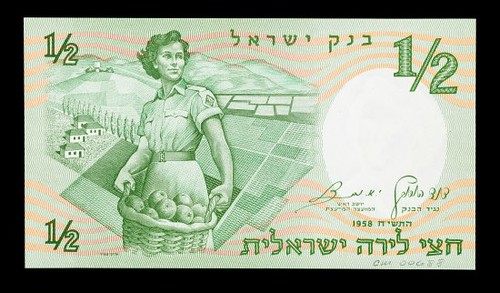
PREV ARTICLE
NEXT ARTICLE
FULL ISSUE
PREV FULL ISSUE
WOMEN AND LABOR ON PAPER CURRENCY
Intern and PhD candidate Kate Steir published an article about depictions of women and labor on paper currency in the March 28, 2016 O
Say Can You See> blog from the Smithsonian National Museum of American History. Here's an excerpt. -Editor
"How often, when man abandons the helm in despair, woman seizes it, and carries the home-ship through the storm! Man often flies from home and family to avoid impending poverty or ruin. Woman seldom, if ever, forsook home thus." –Woman in Adversity from Godey's Lady's Book, 1861 The quote above from Godey's Lady's Book, a popular 19th-century women's magazine, offers a familiar depiction of women as homemakers and mothers sailing the "home-ship." Yet, a banknote issued that same year by the Sanford Bank of Sanford, Maine, depicts two women weaving at industrial looms; a third unattended loom behind them indicates that this is a factory scene, and that these women did in fact leave home to avoid poverty through paid work. Paper currency is not only a symbol of monetary value, it is a form of print media, and consumers look at the images on their paper money every day. Therefore the men who designed the Sanford Bank note made deliberate choices when they selected this image. This isn't the only example of women depicted as laborers on notes. In contrast to the current American norm of featuring famous people on notes, anonymous women at work have been a popular subject for money starting in the 19th century, and they appear in places as far apart as the United States and French Equatorial Africa. In order to understand why everyday women appear on so many types of notes in so many places and times, it is important to understand the role that images on money fulfill. On banknotes issued by governments, detailed images can help to make counterfeiting more difficult, but they also provide an opportunity to depict national values in a place that citizens will see every day. 
In 2015 when the U.S. Secretary of the Treasury announced the redesign of the ten dollar bill to feature a woman, the press release expressly stated that the woman chosen would emphasize something about American democracy. The Israeli half do[pound] note from 1958 is another particularly striking example of notes expressing national values. The image is of a muscular woman wearing a dress, and holding a large basket full of apples. Her hair is windblown and she is standing against a background of manicured fields, where she presumably harvested her fruit. This image sends a clear message: the ideal Israeli female citizen is feminine and strong, and actively participates in the economy. 
1958 Israel Half Pound note To read the complete article, see:
Wayne Homren, Editor The Numismatic Bibliomania Society is a non-profit organization promoting numismatic literature. See our web site at coinbooks.org. To submit items for publication in The E-Sylum, write to the Editor at this address: whomren@gmail.com To subscribe go to: https://my.binhost.com/lists/listinfo/esylum All Rights Reserved. NBS Home Page Contact the NBS webmaster 
|